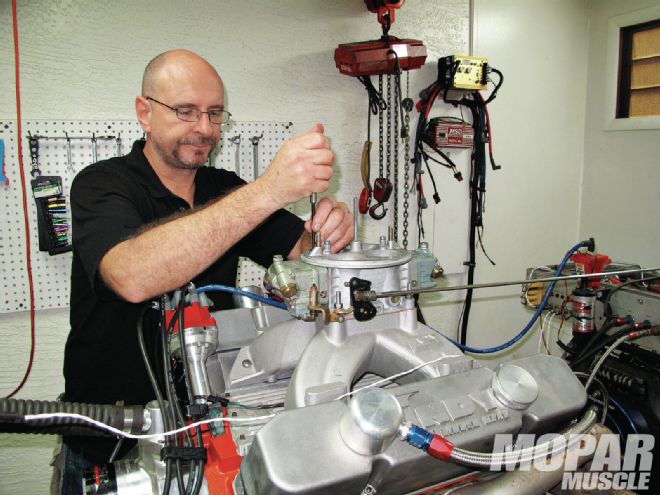
Building a powerful big-block is easier than ever these days, and it's not difficult to make reliable power from the big-block Mopar if you pick the correct combination of parts. But with so many parts available for the Wedge engine, it's often difficult to decide which pieces are right for your application. And while many of us choose to purchase all of our parts new and build the engine ourselves, there is also something to be said for purchasing an engine that someone else might not have had much luck with, make a few changes, and end up with a reliable, powerful engine for an economical price.
This was the case with a 500-cubic-inch Mopar wedge engine that Jim Freed purchased from another local enthusiast. It seemed the engine just wasn't what the original owner needed, so Jim purchased it for a reasonable price and made the good decision to have it checked over at Auto Performance Engines before he installed it in his '72 'Cuda bracket car. With Indy 440-1 CNC ported cylinder heads and a stout solid roller camshaft, Jim also made the good decision to upgrade to a new Mopar Performance Siamese bore block. With the parts selected, we headed over to the shop to follow the teardown and rebuild. This month we'll feature the short-block, and in a future issue we'll assemble the top end and test the big-block on the engine dyno.
As with anything you purchase second-hand, you really never know the condition until you inspect the item closely. In the case of a race engine, this involves tearing the engine completely down to inspect all of the individual pieces before re-assembly with new parts where needed. Upon removing the cylinder heads from this big-block, it was apparent that one of the pistons had been coming much closer to the combustion chamber than the others, which definitely indicated a problem. Further teardown of the bottom end revealed that the number three connecting rod bearing was damaged to the point of being nonexistent, allowing the rod and piston to move closer to the head at the top of the stroke.
Fortunately, the connecting rod, rod bolts, and rod cap hadn't broken, which could have damaged the engine much more severely. Even so, the connecting rod and crankshaft would need to be repaired or replaced, which brought us to a dilemma. We could check and resize the connecting rod and replace the rod bolts, but we'd be taking a chance that the reconditioned rod wouldn't be able to survive the forces applied by a Mopar race engine. Additionally, the crankshaft would require repair, which could be accomplished by regrinding it. In our experience, however, the economically priced crankshafts like this one have very shallow heat treating, so grinding the journals even .010-inch can compromise the hardness of the crankshaft and require it to be re-heat treated.
With these factors and their related expense in mind, Kevin recommended a new rotating assembly for this engine as the best option, both economically and for restoring its performance. He also recommended that since we were replacing the rotating assembly anyway, we may as well upgrade the engine with a 4.5-inch stroke Scat forged crankshaft, Scat 7.100 length H-beam connecting rods, and Mahle forged pistons. Jim also wanted the engine to last, so we opted for flat-top pistons to keep the compression at a reasonable 12.4:1 level, and only bored the cylinders to 4.350 inches, leaving plenty of room for future rebuilds. This 535-cubic-inch engine will still require racing gasoline, but without the extreme cylinder pressures associated with higher than 13:1 compression ratios, the engine should be very durable, lasting many passes down the dragstrip before needing to be freshened up.
The oil system is also a very important part of an engine's performance and durability, especially in a racing application. This engine was already equipped with a single-line Milodon external oil system and fabricated aluminum oil pan, but we decided to upgrade to a dual-line system. The Mopar Performance block has the provision for an external oil pickup line already in the block, so combined with a Milodon dual-line oil pickup and new Melling oil pump, this oil system will be capable of supplying adequate oil upwards of 7,500 rpm.
No matter how good the quality of the parts are, the engine won't perform properly or last very long unless the machining processes are performed accurately. Auto Performance Engines (APE) performed the necessary machine work to the block, including boring and honing with torque plates, checking bore alignment of the main journals, and decking the block to achieve the target compression ratio.
Even with new parts like our Scat crank and rods, bearing clearances need to be rechecked during the assembly phase of an engine build. The owner opted to re-use his Crane solid roller camshaft, and APE installed the cam six degrees retarded to ensure peak power will be attained at a reasonable 7,000 rpm. This is a big camshaft, with more than 280 degrees duration at .050-inch lift and .750-inch or so valve lift with the 1.6 ratio rockers. While this cam is designed to make peak power at 8,000 or more rpm, advancing the cam timing will move the peak power rpm lower.
Be sure to stay tuned, because we'll show you the top end of this engine in a future issue. Of course, we'll dyno the 535-cubic-inch big-block as well and give you all the results of our testing. To see videos of this engine running and being tested on APE's dyno, don't forget to visit www.moparmusclemagazine.com
Price Tag
PartCost Mopar Siamese bore block$2,935 Scat forged crankshaft kit Kit includes: rods, pistons, bearings, rings, Scat H-beam connecting rods, and Mahle forged flat-top pistons$2,300 Professional Products Balancer$220